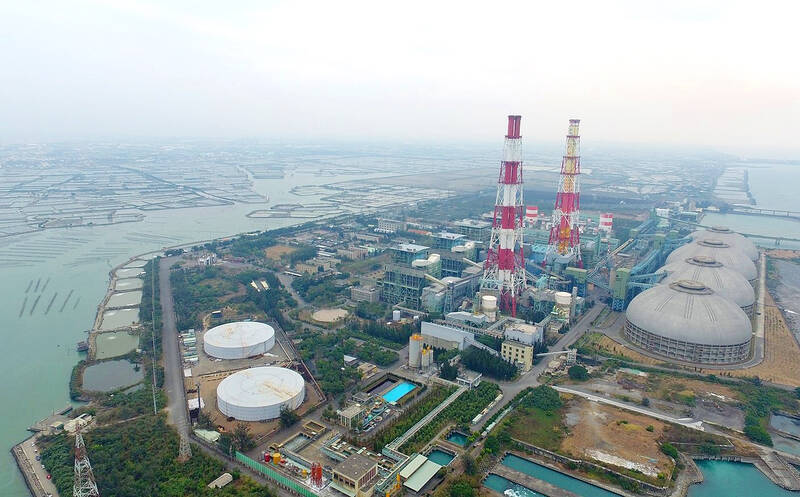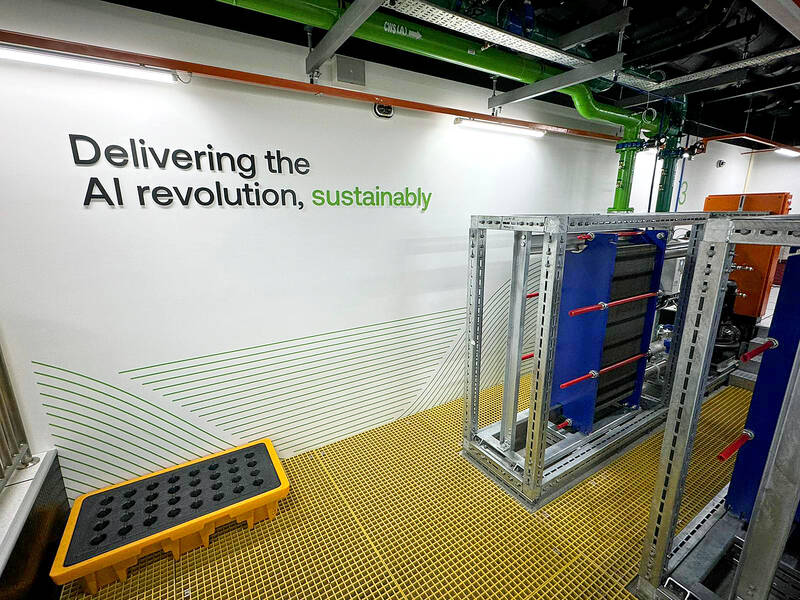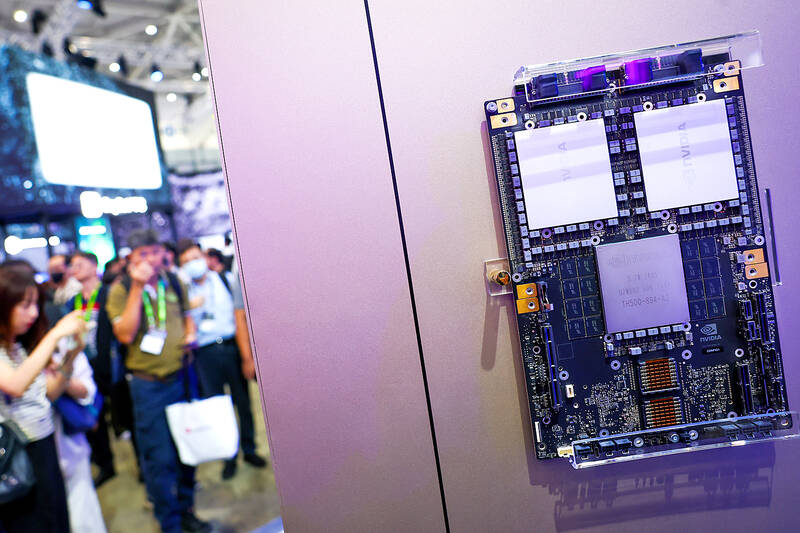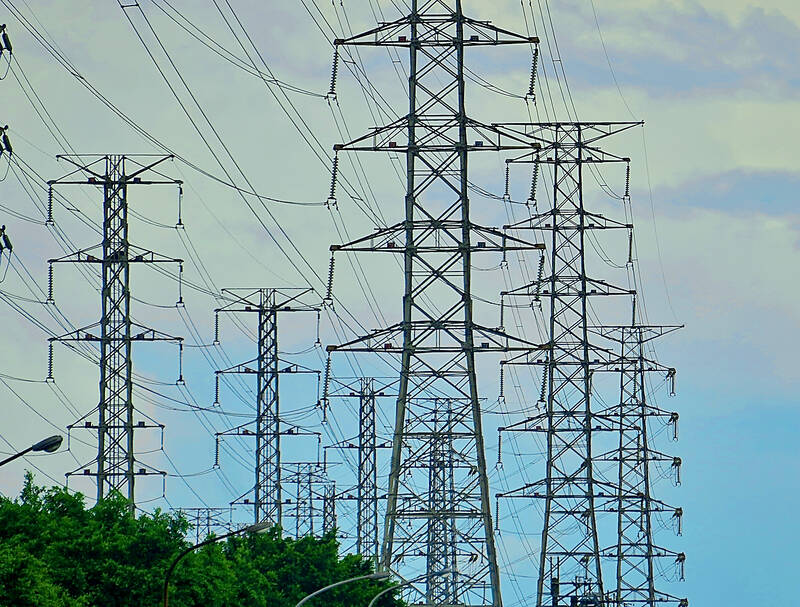President William Lai’s (賴清德) vision for Taiwan to become an “AI island” has three conditions: constructing advanced data centers, ensuring a stable and green energy supply, and cultivating AI talent. However, the energy issue supply is the greatest challenge.
To clarify, let’s reframe the problem in terms of the Olympics. Given Taiwan’s OEM (original equipment manufacturer) roles in the technology sector, Taiwan is not an athlete in the AI Olympics, or even a trainer, but rather a training ground for global AI athletes (AI companies).
In other words, Taiwan’s semiconductor ecosystem provides world-class training facilities and equipment that have already attracted top AI athletes like Google, Microsoft, Amazon, Nvidia and AMD. But for these athletes to train effectively, Taiwan also needs to provide a proper diet to literally power them. They need a balanced diet of quality electricity that Taiwan may not be able to provide.

Photo courtesy of Citizen of the Earth, Taiwan
AI IS POWER HUNGRY
AI systems are like elite athletes with insatiable appetites. Training AI models, particularly complex ones like large language models, requires immense computational power, which in turn requires vast amounts of electricity.
For example, Nvidia’s H100 GPU — a chip that performs around four quadrillion calculations per second — consumes about 700 watts under full load, roughly equivalent to the power usage of an average US household occupant. A data center typically uses 10,000 to 100,000 GPUs. The new Vantage 16MW Data center in Taipei probably has about 20,000 GPUS, and when running 24/7, this smaller data center will consume the power of a small town of 13,000 households.

Photo: CNA
Complex AI models, like large language models, require an incredible amount of computation power and electricity. It has been estimated that in 2020, OpenAI trained its 175-billion parameter GPT3 model on 10,000 Nvidia V100 GPUS over a few months at a cost of around US$4.6 million.
TAIWAN (INDUSTRY) IS POWER HUNGRY
Taiwan is already a power-hungry island. With a population of 23.42 million, the country consumed 276.52 terawatt-hours (TWh) of electricity in 2022, translating to 11,807 kilowatt-hours (kWh) per capita. This is close to the US consumption of 12,702 kWh per capita and significantly higher than Japan’s 7,799 kWh. This high per-capita usage is due to Taiwan’s industrial sector that consumes about 56 percent of Taiwan’s power. TSMC alone consumed 25 TWh last year, which is 9.04 percent of Taiwan’s total power consumption. Greenpeace projects that TSMC will consume 74 TWh by 2030, which is how much energy New Zealand consumed in 2021.

Photo: CNA
Taiwan’s expanding IT and AI industries will increase energy demand by 13 percent by 2030, though Yeh Tsung-kuang (葉宗洸) of the Institute of Nuclear Engineering and Science at National Tsing Hua University challenges this government projection and suggests that a more reasonable estimate is 15 percent growth by 2028.
So, what would a healthy power diet look like?
“To make Taiwan the Silicon Valley of Asia,” Minister of Economic Affairs (MOEA) JW Kuo (郭智輝) recently said, “we need a stable power supply, reasonable electricity prices, and adequate green electricity for companies.”

Photo: CNA
This power diet sounds very aspirational given Taiwan’s unstable power supply, unsustainable pricing, and inadequate progress in green energy development.
TAIWAN’S POWER DIET IS UNHEALTHY
Last year, Taiwan’s power generation was primarily thermal at 83.09 percent (coal 42.2 percent, liquid natural gas (LNG) 39.5 percent, and oil 1.34 percent), nuclear at 6.3 percent, and renewable at 9.5 percent (solar, wind, hydro, and biomass), according to the MOEA.

Photo: CNA
Taiwan’s power supply is inherently unstable. Since more than 96 percent of Taiwan’s energy is imported, its power supply is vulnerable to global market fluctuations and geopolitical risks. Outdated equipment and an overstressed power grid already prompt calls for both citizens and industry to reduce electricity consumption during peak times in the summer. And let’s not forget the power failures. In 2021, a failure at the Hsinta coal-fired power plant caused a massive blackout affecting TSMC and 6.2 million households. Another outage in 2022 disrupted power for over 5 million households.
The excessive reliance on imported coal and gas also puts the island at risk. In the worst case scenario of a naval blockade, Taiwan would have enough LNG reserves to last eight days in the summer and enough coal for about six weeks, according to Taiwan energy and climate specialist Angelica Oung (翁華志).
Taiwan’s electricity is unsustainably priced. The government heavily subsidizes energy costs to keep prices low, but this strategy is becoming increasingly unsustainable especially given the soaring oil and gas prices since Russia invaded the Ukraine. In 2022, for example, Taipower suffered losses of US$8.39 billion and last year US$6.26 billion, even after receiving a US$1.57 billion government subsidy.
Finally, Taiwan green energy development is lagging far behind projections. Despite ambitious goals to increase renewable energy to 20 percent of the energy mix by 2025, the actual contribution of renewables last year was only 9.5 percent. Infrastructure delays, regulatory hurdles, and the intermittent nature of renewable sources like solar and wind have slowed progress. Meanwhile, the phasing-out of nuclear power by next year will further exacerbate the situation because Taiwan will need to import even more fossil fuels like LNG, which will boost carbon emissions.
Currently, Taiwan is offering a junk food diet.
IMPROVING THE POWER DIET
For Taiwan to become an AI hub, the energy issue needs to be practically addressed. Some industry leaders, like Pegatron Corp chairman Tung Tzu-hsien (童子賢), suggest a healthier, more realistic and balanced diet of 30 percent renewable energy and 30 percent nuclear power to reduce Taiwan’s dependence on fossil fuels.
But the ruling Democratic Progressive Party has made a “no-nuclear homeland” a non-negotiable ideological principle, even if it means using more subsidized fossil fuels that generate more Taipower debt, more national security risk, and more pollution. Even Sam Kimmins of the Climate Group RE100 noted at a recent Taipei climate meeting, “We would rather that economies, given the choice, would retire their fossil fuel plant rather than their nuclear plant.”
If Taiwan continues to offer a junk food power diet, it risks losing its competitive edge in the global AI Olympics. The government needs understand and resolve the trade-offs to its green energy initiatives, reconsider its energy mix, and build a more resilient and updated power infrastructure that can support its power-hungry AI future.
Only by offering a healthier power diet can Taiwan truly fulfill its potential as the premier AI training ground and retain the world’s top AI athletes. Only then will it sustainably become an “AI island.”

The Lee (李) family migrated to Taiwan in trickles many decades ago. Born in Myanmar, they are ethnically Chinese and their first language is Yunnanese, from China’s Yunnan Province. Today, they run a cozy little restaurant in Taipei’s student stomping ground, near National Taiwan University (NTU), serving up a daily pre-selected menu that pays homage to their blended Yunnan-Burmese heritage, where lemongrass and curry leaves sit beside century egg and pickled woodear mushrooms. Wu Yun (巫雲) is more akin to a family home that has set up tables and chairs and welcomed strangers to cozy up and share a meal

Dec. 8 to Dec. 14 Chang-Lee Te-ho (張李德和) had her father’s words etched into stone as her personal motto: “Even as a woman, you should master at least one art.” She went on to excel in seven — classical poetry, lyrical poetry, calligraphy, painting, music, chess and embroidery — and was also a respected educator, charity organizer and provincial assemblywoman. Among her many monikers was “Poetry Mother” (詩媽). While her father Lee Chao-yuan’s (李昭元) phrasing reflected the social norms of the 1890s, it was relatively progressive for the time. He personally taught Chang-Lee the Chinese classics until she entered public

Last week writer Wei Lingling (魏玲靈) unloaded a remarkably conventional pro-China column in the Wall Street Journal (“From Bush’s Rebuke to Trump’s Whisper: Navigating a Geopolitical Flashpoint,” Dec 2, 2025). Wei alleged that in a phone call, US President Donald Trump advised Japanese Prime Minister Sanae Takaichi not to provoke the People’s Republic of China (PRC) over Taiwan. Wei’s claim was categorically denied by Japanese government sources. Trump’s call to Takaichi, Wei said, was just like the moment in 2003 when former US president George Bush stood next to former Chinese premier Wen Jia-bao (溫家寶) and criticized former president Chen

President William Lai (賴清德) has proposed a NT$1.25 trillion (US$40 billion) special eight-year budget that intends to bolster Taiwan’s national defense, with a “T-Dome” plan to create “an unassailable Taiwan, safeguarded by innovation and technology” as its centerpiece. This is an interesting test for the Chinese Nationalist Party (KMT), and how they handle it will likely provide some answers as to where the party currently stands. Naturally, the Lai administration and his Democratic Progressive Party (DPP) are for it, as are the Americans. The Chinese Communist Party (CCP) is not. The interests and agendas of those three are clear, but